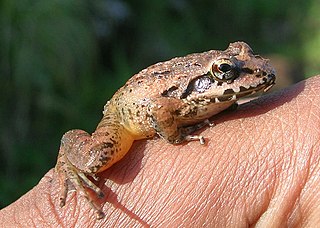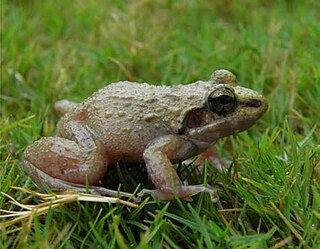
Indirana is a genus of frogs in the family Ranixalidae. These frogs are endemic to the Western Ghats of India. They are sometimes known under the common name Indian frogs, whereas members of their parent family are named "leaping frogs".

Indirana beddomii, Beddome's leaping frog, Beddome's Indian frog, or simply Beddome's frog, is a species of frog found in the Western Ghats. They are usually detected by their long leaps as they flush from the ground when disturbed. The species is named after the naturalist Richard Henry Beddome.

Indirana semipalmata is a species of frog endemic to the Western Ghats region of southern India. They are small frogs, reaching lengths of about 36 mm (1.4 in) from snout to vent. The species breeds during the monsoons, laying their eggs on moist rocks and tree bark. Their tadpoles are terrestrial – hatching, feeding, and undergoing metamorphosis without ever entering any standing bodies of water.

Indirana leithii is a species of frog in the family Ranixalidae. It is endemic to the northern Western Ghats of India. As currently defined, its range is restricted to the states of Maharashtra and southern Gujarat; earlier records elsewhere refer to other species.

Indirana brachytarsus is a species of frog found in the Western Ghats of India. It is locally common terrestrial frog associated with hill streams in wet evergreen and semi-evergreen tropical forests and swamps. It may also be found at forest edges but does not penetrate further to agricultural land. It breeds on wet rocks, and the tadpoles are found on wet rock surfaces next to streams.

Walkerana diplosticta, also known as the spotted leaping frog, Malabar Indian frog, rufous leaf-hopper frog, and Günther's frog, is a species of frog in the family Ranixalidae. It is endemic to the Western Ghats south of the Palghat Gap and only known with certainty from the states of Kerala and Tamil Nadu, India. Localities with confirmed records include the Kalakkad Mundanthurai Tiger Reserve.
Indirana gundia is a species of frog found in the Western Ghats of India. It is only known from its type locality, Kempholey, Karnataka. Indirana gundia is listed among "Top 100 EDGE Amphibians". It represents a family that has been evolving independently in India for almost 50 million years.
Walkerana leptodactyla is a species of frog endemic to the southern Western Ghats in Kerala and Tamil Nadu states of southern India. Precise reports are from Anaimalai hills, Palni hills, Meghamalai, Travancore hills and Agasthyamalai.

Walkerana phrynoderma is a species of frog endemic to the Anaimalai Hills, of the Western Ghats of Kerala and Tamil nadu states in southern India. This species is known from Munnar, Eravikulam National Park, Valparai tea gardens, Anamalai Tiger Reserve, Grass Hills National Park and Palni hills. It is a very rare terrestrial frog species associated with leaf-litter in tropical moist forest. It is threatened by habitat loss caused by subsistence wood collecting. It has the status of one of the "Top 100 Evolutionarily Distinct and Globally Endangered Amphibians."
Indirana tenuilingua is a species of frog that is considered nomen inquirendum. It is only known from the type series, now lost, from its type locality, Kemphole, in the Western Ghats of India. It is sometimes known as Rao's Indian frog or slender-tongued frog.
The Barabuna tree frog is a species of frog in the subfamily Pelodryadinae.
The Cooloola sedge frog or Cooloola tree frog is a species of frog in the subfamily Pelodryadinae.
The Wendessi tree frog is a species of frog in the subfamily Pelodryadinae.

Nannophrys ceylonensis, commonly known as the Sri Lanka rock frog or the Ceylon streamlined frog, is a species of frog. It used to be placed in the large frog family Ranidae but a phylogenetic study was undertaken using DNA sequences and it is now included in the family Dicroglossidae. It is endemic to Sri Lanka where its natural habitats are subtropical or tropical moist lowland forests, subtropical or tropical moist montane forests, rivers and streams.

Nannophrys marmorata, commonly known as Kirtisinghe's rock frog or marbled streamlined frog, is a species of frog endemic to Sri Lanka. It used to be placed in the large frog family Ranidae but a phylogenetic study was undertaken using DNA sequences and it is now included in the family Dicroglossidae. Its natural habitats are tropical moist lowland forests, moist montane forests, rivers and streams. It is threatened by habitat loss.

The Kempholey night frog is a species of frog in the family Nyctibatrachidae.

Rana longicrus, also known as the Taipa frog or long-legged brown frog, is a species of frog in the family Ranidae. It is distributed to northern and central Taiwan.
Philautus longicrus is a species of frog in the family Rhacophoridae. It is found in Indonesia, Malaysia, and the Philippines. In the Philippines, it has been observed between 30 and 1000 meters above sea level, and in Borneo, it has been observed between 700 and 2900 meters above sea level. Its natural habitats are subtropical or tropical moist lowland forests and subtropical or tropical moist montane forests. It is threatened by habitat loss.

Raorchestes tuberohumerus is a species of frog in the family Rhacophoridae. It is endemic to the Western Ghats, India, where it is found in Karnataka and Kerala states.

Ranixalidae is a family of frogs commonly known as the leaping frogs or Indian frogs. They are endemic to central and southern India, specifically in the Western Ghat mountain range. This mountain range encompasses the Indian states of Gujarat, Maharashtra, Goa, Karnataka, Kerala, and Tamil Nadu. Ranixalidae can be found in Maharashtra, Goa, Karnataka, and Kerala. There is a large concentration of them in Goa and Maharashtra, however there are still considerable amounts of species within the southern Indian states of Karnataka and Kerala, where there are other frogs within the Indirana genus.











